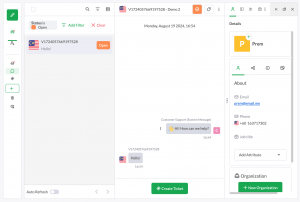Holding remote team members accountable can be challenging.
You may be separated by thousands of miles. You can’t walk down the hall to check in for a quick update. And there’s no conversation at the coffee station.
Time-tracking software has become a popular solution for remote management. It’s an essential tool used by our HR team to record the daily in and out times of our Virtual Assistants. And a growing range of functionality is now available, from video streaming to keystroke-recording mechanisms.
Where do time trackers cross the line and how much is too much? Keep reading to find out more about time-tracking, what we’ve learned working with a remote crew, and what’s working now.
What is time-tracking software?
Time-tracking software includes digital tools used to record overall work hours and/or time spent on specific tasks.
Time-tracking apps and extensions can be integrated with browsers, task management systems, email clients, and CRMs. The simplest versions record check-in and check-out times to show when and how long each team member worked.
Advanced systems capture data from cameras and keyboards. They can provide timed video feeds or records of all keystrokes completed during working hours.

The benefits of time tracking at work
Time trackers can be powerful tools for personal productivity. As an individual, you can use them to identify the most effective hours of the day for different kinds of work. Tracking specific tasks can help you find your strengths and places you need extra support.
The Pomodoro method can work with time trackers to improve focus and mental recovery by breaking up work into short sprints. For example, you can power through almost any task by setting a timer for 25-minute segments and building in five-minute breaks..
The downside of time tracking for remote team management
While time tracking can benefit individuals, it can have drawbacks for remote team management.
A survey of 100 employees found that when monitored, employees were more likely to take extra breaks, damage equipment, and intentionally work at a slower pace. A study by the same team found that when employees believed they were monitored they were more likely to cheat than when they thought no one was watching.
When employees are given responsibility and trust, they are more likely to take responsibility for their actions.

Why we don’t use time tracking software:
Based on our experience, we believe time-tracking does more harm than good.
While it can be useful for individuals, we tried it and decided against requiring its use for remote team members.
When we tested the use of time-tracking software internally, it didn’t work within our organization. It broke down the culture.
- It decreased morale
- It made people feel like they were being watched
- It damaged trust
Our clients, however, are free to choose whether or not to use time trackers to manage their Virtual Assistants.
We asked a group of Virtual Assistants about their past experience with time-tracking software and this is what they told us
One word came up in almost every response: Pressure.
- For those involved in creative work, the feeling of being time-pressured interfered with the ability to focus
- The timer took attention away from the tasks at hand
- Even being aware of the time clock slowed work
Time trackers were seen as limited evaluation tools. One VA noted, “Time tracking only measures the time spent on a task but not the quality,” as some tasks require more time to produce quality output. Workers were penalized for efficiency instead of being given the opportunity to grow in their responsibilities.
Another VA believed using time as the primary metric was misleading: “When we start measuring an employee’s productivity on the reports of a time tracker, even the most responsible of VAs can appear unproductive while the most unreliable of VAs can look good.”
Other respondents reported that a lack of mutual trust damaged their working relationship with the client — especially when combined with micromanagement, intimidation, or advanced browser and app-tracking measures. In one instance, an employee had been accused of not working after having used a music streaming app while working.

How can I know my team is working?
If you want to know your team is working, look at the work that gets done.
Hiring the right people for the right position, empowering them to take initiative, and offering the support they need will help them do the work that adds value to your organization.
Here’s what that can look like:
- Frequent communication
- Tracking key performance metrics — not keystrokes
- Start of the day/end of the day standups
- Project management apps
- Regular meetings
- Providing training as needed
- Support for questions and conflicts that arise
Responses from our team indicate that they prefer to measure work by by the quality and quantity of the work completed:
“Most of us perform better when we know we have the confidence of our employers/clients. I’m usually online 1-2 hours before my schedule to check on things and make sure everything is running fine, and my client appreciates it a lot. Changing this may put me in a position where I’ll be more conscious of the time tracker than the things that need more attention.”
— Virtual Assistant at tawk.to
“At the end of the day, it would still be our output that counts and would say how we did for the day (we also update what we did for the day before our shift ends here).”
— Virtual Assistant at tawk.to
“There’s something about the freedom of not being under time pressure always that makes us work more effectively. And to be honest, it’s one of the main features we like about tawk.to and the clients.”
— Virtual Assistant at tawk.to

How is performance measured at tawk.to?
While we monitor the hours each Virtual Assistant works, we do not record video feeds, browser histories or keystrokes. And we don’t require a timed breakdown of specific tasks unless there is a specific reason to do so.
Instead, the tawk.to HR team has developed its own tool to track the productivity of our Virtual Assistants.
Whenever a Virtual Assistant is placed in a new job role, we ask the client to let us know the metrics and deliverables related to the tasks the VA will be performing. We use this to create a form the VA fills out at the end of each day. Their responses are used to autogenerate a daily End of Day report the client receives by email. The HR team is also on call seven days per week to support the VA and the client.

Good work management starts with good relationships
If you’re hiring the right people and have the right support, you won’t need to use time-tracking software.
Pay attention to the qualities that indicate trustworthiness. Look for a strong work ethic and professional outlook. Then, respond to any issues that arise by working with individuals to manage their performance.
If you would like assistance finding the right people, simply let us know. We are happy to assist.
Have questions about the tawk.to Virtual Assistant program? Schedule a call.




